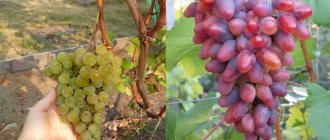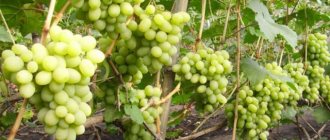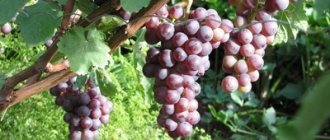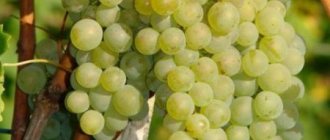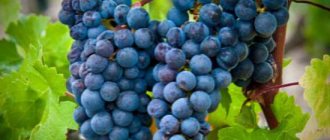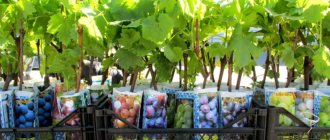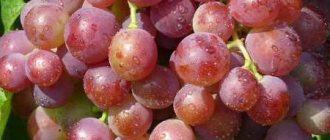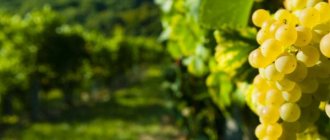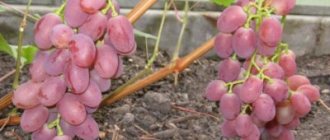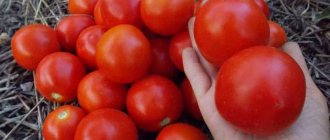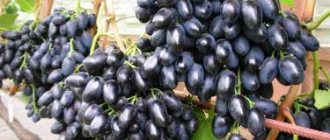Pleven grapes - what kind of variety it is, properties
Bulgarian breeders crossed Yantar and Italy grapes. The result was a beautiful, early-ripening, low-temperature-resistant and productive Pleven variety. Based on this grape, three more subspecies were bred, which have better performance.
Important! The variety is self-pollinating, and for high yields you need to regulate the number of inflorescences.
Description and characteristics, what it looks like
The description of the variety says that Pleven grapes are classified as table varieties. It is one of the fastest ripening - in the south it ripens in 90 days, in more northern regions in 4 months. A large amount of harvest is harvested from one bush.
Pleven grapes
The clusters are large, up to 600 g, cylindrical in shape. The variety does not tend to become smaller, even with insufficient regulation of the number of bunches on the bush. The berries are ovoid, amber, reaching 9 g in weight. Tastes with the aroma of nutmeg. The pulp is quite juicy, fleshy, and the skin is dense.
Sugar in berries reaches 22%, and acidity 7 g/l. From one hectare you can harvest about 14 tons of grapes. The variety can withstand frosts down to -23 °C.
Canopy for grapes
Interesting! Due to its strong growth, it is used to decorate arches and arbors.
Advantages and disadvantages
The Pleven grape variety has a number of advantages over other crops, which should definitely be mentioned:
- easily takes root;
- the productivity is very high;
- tolerates transportation well;
- frost-resistant, and in more northern regions it can easily overwinter under good shelter;
- easy to care for, undemanding;
- resistance to diseases and pest attacks is above average;
- ripens early;
- practically not attacked by wasps;
- After ripening, the bunches can hang on the bush for up to 20 days without deteriorating in quality.
In addition, grapes are self-pollinating and help pollinate other varieties. It is also not subject to peas and tolerates rainy weather well.
Interesting! Seedlings take root in 90% of cases - according to this indicator, it is one of the leaders.
From the Pleven bush you can harvest about 60 kg of grapes. Moreover, rainy weather does not affect the amount of sugar in the berries; they will still gain their 20%.
Of course, despite the large number of positive qualities, there are also some disadvantages:
- in the northern regions you will need to make a shelter for the bushes;
- despite the absence of a tendency to disease, it is necessary to carry out preventive measures;
- the presence of seeds, which is a rather conditional disadvantage.
High-yielding grape variety
Despite so many shortcomings, the variety is quite successful and will decorate any garden plot.
How to properly care for bushes
A prerequisite for proper grape care is timely watering, fertilizing and pruning. For preventive purposes, spraying against pests and fungal diseases must be carried out according to schedule.
Features of watering
Grapes do not like high humidity, but in the first 3 years of life they need to be watered abundantly. For these purposes, a drainage pipe is installed in each hole. Abundant watering is carried out several times during the active season:
- immediately after the opening of the bushes and winter sleep;
- when buds begin to form;
- at the moment of abundant flowering;
- after harvest in late autumn.
Each Pleven grape variety requires abundant watering before the onset of winter. It is believed that wet soil freezes worse and preserves roots
Proper feeding
It is very important for grapes to receive nutrients in a timely manner. Fertilizer is applied according to a schedule at certain periods. Each procedure involves different mixtures.
- After opening the bushes, nitrogenous fertilizers must be added to the soil. These include solutions of chicken droppings or manure. You can also prepare a nitrogenous mixture of 30 g of potassium sulfate, 40 g of urea and 40 g of superphosphates.
- Before the flowers appear, it is necessary to apply similar compounds again under the grape bushes. Nitrogen is necessary for the plant for normal shoot growth and green mass growth.
- When the berries begin to ripen, phosphorus or potassium mixtures must be introduced.
- During the season, it is necessary to carry out several foliar treatments. For these purposes, drugs such as Aquarin and Kemira are used.
- When the harvest has already been harvested, it is necessary to add wood ash to the soil, which helps reduce acidity.
To increase the yield, the bunches are sprayed with boric acid during the period when the ovaries appear. The optimal concentration of the product is 2 grams per 2 liters of water.
Pruning and shaping the bush
Fast-growing grape bushes require mandatory pruning. For Pleven grapes, it should be done in the fall after harvest. The pruning procedure will increase the yield of the bush. There is an algorithm for the correct procedure:
- on each bush it is necessary to leave 4-5 of the strongest and healthiest shoots;
- the fruiting vine is reduced to 8 buds;
- in total there should be 40-45 eyes left on one plant.
An excessive number of shoots has a bad effect on the quality of the fruit. They become smaller, more sour and do not have time to ripen in a timely manner.
In spring, the bush needs to be freed from diseased, weak and frozen branches. It is imperative to normalize the number of bunches. It is recommended to leave 1-2 inflorescences per shoot, the remaining clusters formed are cut off.
In summer, leaves are removed that block light from reaching the grapes. The berries must gain sugar content, and this is only possible in direct sunlight. Also, in the summer, excess shoots are cut off. They take a lot of nutrients and weaken the bush.
Disease Prevention
For Muscat and Resistant varieties, fungal diseases pose minimal danger. To keep plants healthy, all care rules must be followed. For preventive purposes, bushes are sprayed with antifungal drugs twice a season. Treatment should be done in early spring and late autumn so as not to harm the fruits.
It is necessary to dilute the products according to the instructions so as not to harm the plants. During the growing season, treatment is carried out no later than 3 weeks before harvest.
To prevent the spread of fungal infection, it is necessary to use copper-based compounds. The most commonly used are Kuproxat and Khoros.
Grapes are a favorite treat for wasps, mites and caterpillars. Special means will help get rid of them. Spraying is carried out immediately after pests are detected. Wasps and birds cause great damage to the crop. To avoid this, you need to put mesh bags on the bunches.
How to properly cover grapes for the winter
The Pleven variety is not afraid of frost, but it will not survive severe frosts without shelter. You especially need to take care of the plant if the winter is very cold and there is little snow. When the leaves fall and the bush is preparing to go dormant, you need to prune and remove the plant from its support. To make the shelter more dense, the bush is twisted and placed in trenches. It should be dug in with earth on top, covered with dry leaves and covered with spruce branches.
Also in the northern regions, special structures are built from wooden panels, slate and roofing felt. The plant must breathe, so you need to leave small holes on the sides. With the onset of frost they also close.
Snow protects grapes well from the cold. If there is a lot of it, then the bushes will remain safe and sound
Variety varieties
Thanks to the Pleven grapes, several more tasty and strong varieties of sweet berries have appeared. Their description differs little from the parent variety, but they no less deserve attention and a place of honor on the gardener’s plot.
Grapes Pleven resistant or Augustine
This variety is also known as Phenomenon, and its parents are the classic Pleven and Vilar Blanc. The variety is recommended for growing in the North Caucasus region, but given its high ability to tolerate frost, it can be found in more northern regions.
Augustine
Important! It tolerates transportation well and practically does not get sick, which is why it is widely grown on an industrial scale. It is easy to care for and ripens early.
Pleven muscat grapes
The Muscat subspecies was obtained by crossing Druzhba and Strashensky. The most wine-producing of all varieties, it has a very high yield and ripens in three months. The clusters are dense, the berries are able to collect 21% sugar.
Reviews from gardeners
Pleven Muscat is grown.
The variety has proven itself well in that it rarely gets sick and is not affected by pests. It makes amazing homemade wine. There are two bushes growing in the garden. Each one produces 15-17 clusters. Their weight is approximately 700 grams. The bunches can hang for a long time when ripe and do not fall off. They retain their taste and presentation for a long time.
Denis
Pleven grapes have virtually no disadvantages. It requires virtually no maintenance; I feed it once a year, in the spring. Never gets sick, winters well, albeit under cover. The grapes ripen towards the end of summer. It takes a long time to mature, but it's worth it. The taste of the berries is excellent. Do not sour, sugar in moderation. You can easily make wine or compotes. I tried to reproduce it once, and it worked. All cuttings have taken root. They grew quickly, there was no waste. In general, a very worthy variety.
Growing areas and features
Initially, the Pleven variety was bred for Bulgaria, and accordingly, the conditions for growing there will be the best. Despite this, it takes root well in the Moscow region, and in general, central Russia is excellent for growing, but winter insulation needs to be done.
In the south of the country, there is no need to remove the vine from strengthening and insulate it, but you should take into account the specifics of planting, perform regular pruning and shaping of the bush, and also do regular spraying against possible diseases.
Area of application of fruits
Pleven grape varieties for table use. Fresh berries are very tasty. Preparations for the winter are no worse. Jam, marmalade, and jam are made from grapes. Grape compote and juice are very tasty. Masters use the variety to produce table and dessert wines.
Fresh Pleven grapes can be stored in the refrigerator for up to 60 days. The berries do not wrinkle, do not crumble during transportation, and retain not only their presentation, but also their beneficial properties.
Some gardeners use grapevines in landscape design. It will age well throughout the growing season.
Features of planting and growing grapes
That unique grape variety that can be grown in partial shade. Pleven is unpretentious, but, if possible, it is still better to plant the bush in the sun. Another positive quality of this variety is its tolerance to drafts. But Pleven most likely will not tolerate drought, and therefore it is necessary to water it abundantly, especially in extreme heat and in the absence of precipitation.
Landing dates
Pleven grape seedlings can be planted in spring or autumn. But it should be taken into account that the further north the region is, the better it is to give preference to spring planting. This will give the plant time to grow stronger and gain strength before frost sets in.
Interesting! In central Russia, grape seedlings are planted in April, and in the North and Urals this should be done in May.
In the fall, be sure to plant no later than October; even in the south in November, the weather can deteriorate sharply, and if the roots of the seedling freeze, it will die.
Pleven seedling
Site selection and soil preparation
Since Pleven is not a very demanding plant, you can plant it in partial shade and even in an open area, but always with a low groundwater content. You should first dig a hole for the seedling and let it settle for some time.
Interesting! When planting in spring, it is better to dig a hole in the fall. This will contribute to better survival of the grape seedling and its rapid growth.
It is better to put humus in the hole in advance, after mixing it with soil in equal proportions. It should be filled to about a third of the total volume. When planting several shrubs, maintain a distance of at least 2 meters between them.
How to choose the right seedling
When choosing a seedling, you should pay attention to the general condition of the cutting, its root system and blossoming leaves. All parts of the plant should look healthy, without signs of disease. Light green foliage and beige roots indicate a healthy specimen.
Important! The roots should be free of rot, mold and dead parts.
Planting process step by step
After a healthy, strong seedling has been acquired, it must be planted in a prepared area. But some activities are best done in advance:
- dig a hole 1 meter deep and 1 meter in diameter;
- pour 15 cm of drainage onto the bottom - crushed stone or expanded clay will do;
- cover a third with organic matter.
Be sure to add a mineral complex before planting; a phosphorus or potassium mixture is best. You can buy it ready-made in a specialized store.
After that:
- add 250 g of wood ash;
- make a mound of garden soil in the center and place a seedling on it;
- straighten the roots carefully;
- sprinkle soil on top;
- compact.
Abundant watering
On the day of planting, you need to pour up to 40 liters of water onto one bush and cover the tree trunk circle with mulch on top. After this, the young shoot will need to be given special attention until it takes root.
Care
Caring for this grape variety is not difficult. This is a pretty good reason to choose Pleven if you are a beginner winegrower. The main thing is not to fill it with water, otherwise the risk of developing fungal diseases increases.
Watering
In the first year after planting, the watering scheme is as follows:
- 1st month - once every 7–10 days;
- 2nd month - once every 14–20 days;
- from the 3rd month - once every 30 days.
10–20 liters of water are added to each young bush. If the weather is rainy, watering is postponed until the top layer of soil dries to a depth of 15 cm.
From the second year of plant life on the site, watering is carried out according to the following scheme:
- spring after removing the covers - 30 liters each (if autumn moisture-charging irrigation was not carried out or the winter-spring period was too dry);
- before flowering, 20 liters per bush;
- after flowering 20 liters per bush;
- during the period of fruit filling, 10 liters per bush;
- a month before the onset of frost, 50 liters per bush.
Important! Do not use drip irrigation or sprinkling - this will cause high humidity in the soil and cause the development of pathogenic microorganisms
-
pathogens of oidium and mildew.
After each moistening of the soil, it is necessary to loosen the soil to a depth of 15 cm next to the tree trunk, 20 cm between the rows. After loosening, the soil must be mulched to retain moisture and reduce the risk of infection by harmful microorganisms.
Top dressing
Fertilizer application is mainly combined with watering.
In the first year after planting, the plants have enough nutrients placed in the hole, so fertilizing begins in the 2nd year:
- Immediately after removing the covers, you need to dig up the soil under the bushes and cover it with rotted manure.
- Before flowering, it is better to use superphosphate (40 g) and potassium salt (10 g). The mineral complex is added in this proportion to 10 liters of water. This is enough to water one plant.
- During the setting phase, yeast milk is added. To prepare it, add a pack of yeast and 2 tbsp to 10 liters of warm water (+35°C). l. Sahara. When a layer of foam forms on the surface of the liquid, you can stir it and water it. 10 liters is enough for 1 m².
- During the period of fruit filling, you can carry out foliar feeding with the drug “Emochka-Fertility” according to the instructions.
- Before preparing for winter, 40 g of dolomite flour and 10 g of potassium phosphate are added to the soil.
Trimming
Pruning of shoots should be carried out annually, taking into account the fact that the largest number of bunches are formed on one-year-old shoots. On average, a bush can be loaded with 35–40 eyes. Not worth it anymore.
Important! Growth processes in grapes occur polarly, that is, the fruit-bearing upper shoots strongly stretch upward, and the lower ones, on the contrary, slow down their growth. When tying up shoots to increase productivity, they need to be fixed in a horizontal position.
Shelter for the winter
A major shelter for the winter will need to be built in the first year after planting; in subsequent years, it will be enough to cover the plants with thick cardboard and cover the top with a tarpaulin.
In the fall, damaged branches are pruned, the shoots are shortened by 3 eyes. The vines are then collected into a sheaf and tied using a piece of cloth. A layer of soft hay is laid on the ground, on which a sheaf of vines is placed. Next you need to build a cover from boards. The main task is to install it so that there is a distance of 5 cm from the vine. Thick polyethylene is laid on top of the boards. In the southern regions, this variety does not require shelter for the winter at all.
Reproduction of the variety, how and when to do it
During pruning, many healthy and strong branches remain. It is enough to put them in a bucket of water, and they will give strong, healthy roots. The main thing is to choose seedlings with at least five buds.
After white roots have appeared on the branches and have grown a little, the grapes are planted in a pot with a nutrient mixture. It is best to use organic fertilizers and garden soil mixed 1:1.
Now the seedling will overwinter well indoors. If planting is done for the summer, then the grapes should still grow indoors until next spring. When warming occurs, you can plant the plant in your garden plot.
Characteristics of bunches and berries:
The “Plevna” bunches are commercially sized, with an average weight of 500-800 grams, conical to cylindrical in shape, moderately loose.
The shape of the grape seeds is ovoid and elongated. The grains are large, with an average weight of 5-8 grams. The sizes of the berries are as follows: length 20-30 mm and width 10-15 mm. The skin covering the medium-thick berry is crispy. The inside of the grapes is crispy.
Pest control and disease prevention
Pleven is quite resistant to various diseases, but it is still necessary to perform preventive treatments:
- Bordeaux mixture will prevent mildew, treat 3 times per season, and Profit Gold will help cope with the disease;
- against gray rot they are treated with preparations with a high copper content, and if the plant is damaged, Fitosporin will help;
- a lime-sulfur mixture in the form of a solution will help the plant become more resistant to grape itch, and Actellik will cure if the disease has manifested itself.
Pleven grapes are one of the strong and unpretentious varieties. Even an inexperienced gardener can grow it. Simple steps will help you get a rich harvest and decorate your yard and garden.
Botanical description
“Pleven” belongs to the ultra-early grape varieties, and its growing season lasts 95-105 days. Harvesting begins with the period of consumer ripening of grapes and can last for a month. At the same time, the taste of the berries will only improve, and a pleasant nutmeg will appear. In normal years, this is the second ten days of July and “Pleven” can hang until the twentieth of August.
Hybrid "Pleven" has increased resistance to low winter temperatures. It can withstand record low temperatures for grape crops, below -25-26 degrees. The yield of the hybrid variety "Pleven" is used for technical viticulture. Its yield per hectare is 100-120 centners per hectare.
Advantages and disadvantages
The advantages of this variety include: high productivity, large fruits with a pleasant taste, early or mid-early ripening, the possibility of extended harvesting and its transportability. In addition, according to the results obtained during field tests in the natural conditions of the Anapa zonal experimental station, this variety of crop is weakly affected by mildew and oidium and is highly resistant to gray rot and anthracnose.
The main advantages are considered to be high productivity and the regenerative ability of the vegetative organs of the plant
The variety is positioned as well adapted for the northern regions: medium-winter-hardy, capable of wintering without additional shelter in frosts down to −21… −24 degrees. This fully justifies one of its names – “Pleven stable”.
The main problem that amateur winegrowers encounter when growing Augustine is susceptibility to the leaf form of phylloxera. You can learn in detail about the causes and signs of phylloxera infection, as well as ways to combat this insect pest, from the following video:
Brief overview of varieties for wine making
The best table grape varieties, which differ in taste and purpose:
- Riesling. White variety bred by German breeders. It is grown for the production of fine white wines and champagne. Medium-yielding variety with small berries, delicate aroma and weak sourness.
- Semillon. Wine grape variety of France with medium ripening period, high yielding. The berries are white, aromatic and very sweet. Most often cultivated for the production of semi-sweet wines such as Chateau-Iquem.
- Gars Levelu is a grape bred in Hungary. This is a medium-yielding variety that is grown for making Tokaji wines.
- Silvaner or German Riesling. This is an early ripening white wine hybrid bred in Australia. The fruits have a delicate and harmonious taste. This grape is popular in the production of cognac and champagne wines.
- Pinot white. A successful early-ripening species, which first appeared in France, is characterized by high productivity. This is an excellent product for preparing dark wine drinks with a golden color.
- Feteasca alba is a valuable variety bred in Hungary. The berries have high taste and are an excellent raw material for producing expensive vintage wines and champagne.
- Sauvignon belongs to the group of French wine varieties. The berries are white, dense, juicy, with a harmonious taste. This variety is cultivated to produce table wine drinks, as well as champagne and semi-sweet wines.
- Traminer pink. Cultivated in the southern regions of Ukraine and Moldova. This hybrid with early or medium ripening berries is used in the production of table, dessert and champagne wines.
- Chardonnay is one of the most famous table wine varieties. The berries produce excellent champagne and high quality white wine.
- Rkatsiteli is a valuable variety bred in Georgia. Gives tasty and juicy white berries. Rkatsiteli is grown to produce delicious table wines, champagne and Tokay-type wines in large volumes.
- Tsitska is a wine hybrid that is very popular in the Georgian wine industry. It is cultivated for the preparation of champagne and table white wines.
- Bayan Shirey is a high-yielding variety, mainly grown in Azerbaijan, Uzbekistan and Kazakhstan. It has proven itself well as a material for making tableware, champagnes, strong wines and cognacs.
- Voskehat is an ancient Armenian variety. Characterized by late ripening. Cultivated for the production of strong wines such as Madeira, Sherry and Port.
- Sukhomalinsky white is a high-yielding wine grape variety. The berries are juicy and very sweet in taste. This is an excellent raw material for the production of champagne and white vintage wines.
Related article: Grape variety Cardinal AZOS
pros
Despite the small size of the bunches, gardeners really like grapes due to their ease of care and quick response to attentive attention . The main advantages of the variety:
- high level of pollination;
- large harvests;
- earlier maturation;
- stable fruiting;
- high level of transportability;
- presentable appearance;
- excellent taste;
- high degree of frost resistance.
This variety begins to bear fruit quite early.
The main characteristic difference from other varieties is the fact that Pleven is able to self-pollinate in almost any conditions, regardless of weather and climatic conditions . Thanks to this fact, the plant does not produce small fruits, that is, there is no tendency to peas, and the berries on the cluster always ripen at the same time, and uneven ripening does not occur. Among other things, the crop is an excellent pollinator for other varieties, which significantly increases its characteristics.
It is worth noting another positive fact - despite bad weather or other stumbling factors, the crop exhibits stable fruiting . There are no failures or reactions to external factors that could be an obstacle to obtaining a harvest.
The bushes quite comfortably tolerate a drop in temperature to 22 degrees with a minus sign. It is for this reason that when grown in the southern regions, bushes do not need shelter.
Pleven 1
The variety Pleven 1 owes its origin to the breeders of the city of Pleven, Bulgaria, the Institute of Viticulture and Winemaking. The fruit ripening period is very early. Table grape variety. It is characterized by rapid growth and rich fruiting. In farm vineyards 10 kg per square meter. meters of area. Does not require additional pollination. The bunch is loose, conical. Weighing 195-200 g. Medium-sized berry 3.5 - 3.62 g, shaped like an egg. Color yellow-green. The shell is thin, delicate, and cannot be felt when eating. The pulp has a neutral, harmonious taste, juicy and tender. Fully ripened fruits contain 18.3% sugar and 3.9 g of acid.
The variety is resistant:
- to cracking;
- to rot;
- transportable.
Unstable:
- to powdery mildew;
- to the oidium.
The weight of one bunch of Pleven grapes can reach 200 grams
Landing rules
Seedlings of the Pleven variety should be planted in accordance with the basic requirements:
- planting at higher elevations;
- in case of high groundwater levels, carrying out measures to arrange drainage;
- preliminary digging of the site for planting with the application of organic fertilizers;
- preparing holes for planting in advance and filling them one-third with humus and fertile soil;
- the distance between bushes must be at least 2 m;
- When planting, the root collar of the seedling must not be buried;
- After planting, the soil is covered with a layer of high-quality mulch, and the seedling is tied to a support.
In the first ten days, the process of survival of young plants should be monitored and timely watering should be carried out, followed by loosening the soil.
Agrobiological characteristics
Plants have high growth vigor. The leaves grow dark green, round, medium to large in size, five-lobed with a strong degree of dissection, smooth surface and without pubescence on the reverse side. The upper side notches are deep, closed, with a narrow elliptical opening and a sharp bottom, the lower cuts are of medium depth, open, slit-like with parallel sides. The petiole notch is deep, open, arched, and wide at the base. The denticles along the edge of the leaf blade are tall, triangular, with a narrow base, straight edges and sharp apices. The flowers are bisexual and are perfectly pollinated by their own pollen in any weather. In addition, according to reviews from winegrowers, Pleven is a good pollinator for varieties with a functionally female flower type. The ripening of annual shoots is early and complete. Autumn leaf color is yellow.
The variety's clusters are of medium size - 18-20 cm long and 16-18 cm wide, conical or winged in shape, of moderate density. The average weight of a mature brush is 250−320 grams. The comb is quite long, graceful, and light green. The berries are large and very large, elongated-cylindrical, 23-25 mm long and up to 18 mm in diameter. The color of the grapes is yellow-green, often with a tan on the sunlit side, the average weight is 5-6 grams. The surface of the berries is covered with a thick light pruin coating. The pulp is juicy, fleshy-crispy with a pleasant harmonious neutral taste, without any specific notes in the aftertaste or aroma. The juice squeezed from grapes is quite sweet due to its low titratable acidity (5-5.5 g/l), although its sugar content is also very moderate (15-16 g/100 ml). The skin of the berries may seem thick, but due to their fragility and tenderness, they can be chewed without any problems. There are seeds, but they do not have an excessively negative effect on the taste of the crop. There are only one or two of them in each berry. Tasting assessments always show very good results. According to gourmets, Pleven resembles its famous ancestor - the ancient Turkish variety Karaburnu, which has exceptional fruit quality.
The harvest is excellent for fresh consumption and canning. From the point of view of external data, our Bulgarian hero is somewhat inferior in attractiveness to larger-fruited varieties of grapes. However, in terms of the nobility of taste, not every competitor is able to outshine it. It makes excellent light juices and compotes, as well as beautiful preserves and jams. The collected bunches can easily withstand transportation over long distances, and due to the significant thickness of the skin of the berries, they are also well stored, which is not always typical for early ripening grapes. If you carefully lay out the Pleven brushes in a cool room with low positive temperatures and low relative humidity in one layer on a bed of straw or sawdust, or hang them here on a wire, you can preserve the harvest for three or more months.
The growing season from the moment the buds awaken until the onset of removable maturity in the variety is 115−125 days. Thanks to such relatively short terms, in its homeland it ripens in early August, and in our country, in the Lower Don region, at the end of the first - beginning of the second decade of the same month. To achieve the required conditions, Pleven requires about 2450−2550°C of the sum of active temperatures. This theoretically makes it possible to expand the geography of its cultivation to the latitude of Ryazan, Kaluga and Kaliningrad, however, one must take into account the weak frost resistance of plants and the need, therefore, in the northern regions to very carefully cover the vine for the winter.
The yield of the variety is quite high for its time, but is significantly inferior to modern productive varieties. In Bulgaria, with the Guyot formation widespread there, up to 5 kilograms of grapes are obtained per bush, and up to 100 centners of products per hectare with a planting density of 2000 plants per given unit of area. In amateur plantings with good care, our winegrowers achieve slightly better results, but they rarely get more than 10 kg per bush. The relatively low productivity also has a positive side - the plants rarely suffer from overload, the shoots and bunches always ripen on time, and the winegrower does not need to carry out exhausting, careful regulation of the crop load.
Description of a grape plant called pleven
Pleven is a table variety. Grape fruits begin to ripen in August. They can hang for 2-3 weeks without losing their presentation and taste, which is why many gardeners choose it for growing in their garden plots.
The shoots ripen well and the vines grow with great vigor. The weight of a bunch ranges from 520 to 800 grams, and some specimens can weigh a kilogram or more. The bunch of grapes has a conical shape, characterized by medium density and looseness, thanks to which all the grapes on the vine ripen. A small number of fruits rot.
Flowers on a grape bush are of two sexes: male and female.
Grapes with crispy and fleshy pulp weigh from 4 to 6 g, which is one of the largest masses of grape fruits in general. The berries have an oblong shape, their color is yellow-green or amber, the thick skin has a dense waxy coating. The fruits are very tasty, sweet and sour in nature. The sugar level in them is 15.7 g/100 cm3, and the acidity is 5.4 g/dm3. Even in the summer, when it rains all the time, the level of sugar content in the fruit does not decrease in any way.
